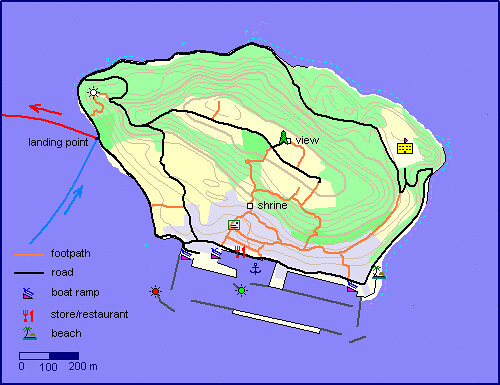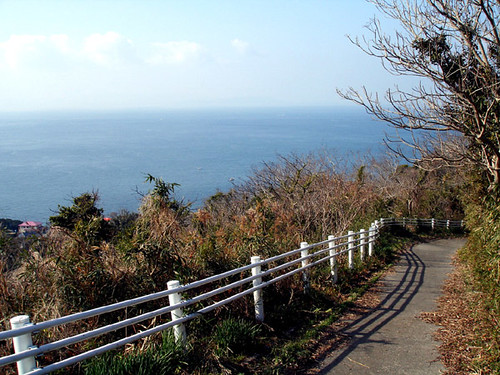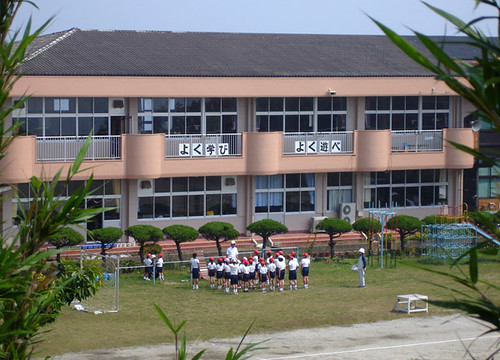Yushima
 Yushima is a small island situated more or less in the middle of the lower Shimabara Bay. Visible from most of Amakusa’s north shores, it has a unique profile, with steep sides and a flat top. Because of the island’s round shape, this profile hardly changes when viewed from various directions. And like any distant land on the horizon, it exerts a certain pull on the adventurous kayaker.
Yushima is a small island situated more or less in the middle of the lower Shimabara Bay. Visible from most of Amakusa’s north shores, it has a unique profile, with steep sides and a flat top. Because of the island’s round shape, this profile hardly changes when viewed from various directions. And like any distant land on the horizon, it exerts a certain pull on the adventurous kayaker.Perhaps the most interesting way to access Yushima by kayak is from Wakamiya beach, a small public facility located in the town of Oniike on Amakusa Shimo Island. From here, the island lies about 15km to the ENE. Although by no means the closest, this access is convenient because it is roughly aligned with the direction of the tidal currents, which in this area are rather strong. Thus one can have the pleasure of progressing at double digit speeds while leisurely paddling along - if one could always move this fast, kayaking would be a completely different sport!
We imagined riding the current would be easy when we first set out on this tour a couple years ago. But we ended up struggling both ways and it took two more trips to figure a reasonable route to take maximum advantage of the flow, because its speed and direction varies considerably from place to place due to the influence of the surrounding coasts and the uneven profile of the seafloor.

On this map, we show the more or less optimal approach (blue) and return (red) tracks, along with the directions and speeds of the currents at intervals along each track (the scale for the current speed appears above the distance scale). The inbound leg should be done at mid-flood, and the return at mid-ebb tide. This gives one several hours to explore the island while waiting for the tide to turn. If the trip is attempted at spring tide, each leg will take an average paddler less than 2 hours to complete. However, if you deviate significantly from the tracks or time frames, you will end up fighting the current and spending much more time and energy than that. Take our word for it!
 Climbing up on land, one can observe the currents around Yushima boil and swirl. This can easily intimidate a kayaker. In any case, this is clearly not a beginner's trip, involving as it does much open water and difficult navigation. And as the tide changes, depending on the wind, the sea may either suddenly calm or with little warning roil up with roaring tidal rapids.
Climbing up on land, one can observe the currents around Yushima boil and swirl. This can easily intimidate a kayaker. In any case, this is clearly not a beginner's trip, involving as it does much open water and difficult navigation. And as the tide changes, depending on the wind, the sea may either suddenly calm or with little warning roil up with roaring tidal rapids. Any locals that happen to see our chosen method of transport will be utterly unable to understand how a kayak could be made to navigate these waters. The farmers typically have no direct experience with the sea even living completely surrounded by it in a place such as this, and imagine it a great void filled with demons and other unfathomable terrors. This image is in fact prevalent nearly everywhere in Japan, a fact that surprised us when we first came into this land where the sea is never too far away. But in fact for the Japanese, the sea is the end of the world, and for hundreds of years in the past, when no one was allowed to leave the archipelago, this was literally so. Today, it is still quite incomprehensible to a foreigner that even here in the south of the country, many of the local childern have never even so much as waded into the beautiful sea that's right in their back yard.
Any locals that happen to see our chosen method of transport will be utterly unable to understand how a kayak could be made to navigate these waters. The farmers typically have no direct experience with the sea even living completely surrounded by it in a place such as this, and imagine it a great void filled with demons and other unfathomable terrors. This image is in fact prevalent nearly everywhere in Japan, a fact that surprised us when we first came into this land where the sea is never too far away. But in fact for the Japanese, the sea is the end of the world, and for hundreds of years in the past, when no one was allowed to leave the archipelago, this was literally so. Today, it is still quite incomprehensible to a foreigner that even here in the south of the country, many of the local childern have never even so much as waded into the beautiful sea that's right in their back yard.A detailed map of the island, based on Japanese topographical maps as well as our own GPS explorations. The landing point shown is convenient both from the point of approach and departure, as well as offering more privacy than the beach in town to change out of one's wet clothes. There is a small pebble strand to land on and stairs through the concrete seawall; the boats can be carried up and dumped in the weeds on the inland side of the road.
 After changing out of our wetsuits, we walk the short distance to the village to eat tasty fried noodles in the tiny shop/restaurant at the port. Yushima has the distinction of being the most isolated of the area's inhabited islands; Nokama-shima, the nearest inhabited land, is more than 4km away. This does not sound impressive, and it does show how compact the Amakusa archipelago really is. Yushima is very interesting to us because like many similarly isolated places in Japan, a certain quaintness and charm is preserved here. That is to say, some of the infrastructure is actually more than 20 years old! In a country where things are being ceaselessly torn down, rebuilt, and re-concreted over, one can’t expect a medieval village; it’s still the same clapboard and concrete everywhere, but at least it has some lichen on it, it’s well used and thus somehow more esthetic than the sickeningly uniform and artificial results of the transformation of the natural environment that is rampant most everywhere in this country.
After changing out of our wetsuits, we walk the short distance to the village to eat tasty fried noodles in the tiny shop/restaurant at the port. Yushima has the distinction of being the most isolated of the area's inhabited islands; Nokama-shima, the nearest inhabited land, is more than 4km away. This does not sound impressive, and it does show how compact the Amakusa archipelago really is. Yushima is very interesting to us because like many similarly isolated places in Japan, a certain quaintness and charm is preserved here. That is to say, some of the infrastructure is actually more than 20 years old! In a country where things are being ceaselessly torn down, rebuilt, and re-concreted over, one can’t expect a medieval village; it’s still the same clapboard and concrete everywhere, but at least it has some lichen on it, it’s well used and thus somehow more esthetic than the sickeningly uniform and artificial results of the transformation of the natural environment that is rampant most everywhere in this country.We always have fun walking around the narrow steep paths of the village clinging to the hillside, with its numerous cats and bizarrely shaped banyan trees. Higher above, the path breaks through a band of forest and scrub that hugs the steepest parts of the hillside. Climbing steeply through this, we enjoy the wide views of the sea, now from a higher perspective. The town and port rest directly below.
Then suddenly, we break out onto the surprisingly flat top of the island. Here, the land had been cleared for agriculture long ago, but as the island depopulates along with the rest of the Japanese countryside, much of it lies fallow now. However, there are a few greenhouses where baby's breath thrives thickly. There seems to be enough of the stuff to supply the needs of all the florists in south-west Japan!
A look at the Yushima Elementary School completes the tour. Japanese schools are, like in most other places, a concise look at the native society. What we see here are, most likely, all the kids of the island assembled in front of the spacious building which contains, well, about one classroom per student. Was the government anticipating some kind of population explosion here when they planned this colossus? No, in fact, this situation points only to the gross overspending, inefficiency, and corruption of the Japanese bureaucracy. (Consider also that Yushima, along with 40% of all Japanese towns, still does not have a sewer system per se, or a waste water treatment facility.) The school as well as the concrete seaport, seems to be in fact a thinly concealed buildup of the infrastructure for none other than military purposes. There is so much of this kind of stuff around now, as well as the roads crisscrossing the mountainsides, that to destroy it all would probably take more conventional explosives than even the Americans possess. Japan is currently militarizing even further (in spite of its constitution prohibiting the military, Japan has always had one), and fighter jets, helicopters, camo jeeps or troops in fatigues marching around the mountains are an increasingly common sight. These kids here too, all they need is a change in the color of the uniform. Where Canadian kids run around the playgound at recess, these ones are marched around the yard by their authoritarian teachers. A banner on the school, which rather reminds me of my own childhood spent in a Soviet-bloc communist country, reads, "Learn well, play well" when in fact, any playtime is nearly over for these kids who from junior high school till nearly the end of their lives will experience 12+ hour, 6+ day work weeks and virtually no meaningful free time. The peaceful, almost quaint, aspect of this scene only completes the Orwellian atmosphere here on an island barely a kilometer across, in rural southern Japan.
After a few hours on the island, we see that the tide has turned. We descend back to our boats, don our rubber suits, and set out on the sea again. The ebb current grabs us, and Yushima recedes quickly astern.






3 Comments:
congrats for all these beautifull pics! ;)
By Unknown, at 2:09 am
Unknown, at 2:09 am
You have no idea what you are talking about when it comes to the lives of school children. The elementary schools in Japan are much less strict than most American schools and don't have ridiculous policies like "zero tolerance."
(My children have spent time in both the American and Japanese school systems.)
By Anonymous, at 9:33 am
Anonymous, at 9:33 am
hi anonymous,
thanks for your thoughtful comment, honestly. not only am i happy that someone is still reading our blog that we spent a lot of time putting together; also it was nice to reread my own commentary which reflects the mood i was in around then (perhaps a little wiser now, i prefer to turn a blind eye to such things if i can). that said, i still don't think i was so much off the mark, all things considered. in fact, the increasing nationalism and sabre rattling with china of late have put some of those things into even sharper focus. BUT i also agree mostly with what you said. note that i did say 'playtime is almost over' for these kids, implying that elementary school is in fact one small and rare window of temporary freedom in japanese society. i'm also on your side with the zero tolerance policy thing though i would imagine things would change here pretty fast if kids here started bringing guns and knives to school (as it is, they are not allowed even chewing gum, chips, or pokemon keychains, and zero tolerance would not make much sense here anyway since not a single kid would think of bringing any such things to school - rules here seem to be beyond need for enforcement. one oversight i committed in my report is that the school is a combined junior high and elementary school, and the kids pictured may in fact be JHS students. the way JHS and HS students are treated is drastically different from ES and very stressful and i believe damaging for most of them. i'm guessing that either your kids did not partake of post-elementary education here, or you are of the persuasion that six years of boot camp is a good formative experience for teenagers. i think that school discipline is important (and lacking in places like Canada) but the stress, exhaustion and sleep deprivation are a little too much for the developing brain of a young adult. on the other hand i believe that it is this more than anything else that ends up producing one of the most orderly and crime-free societies in the world. is this a good thing or is it the proverbial peace of the lobotomized? i guess that is for each individual to decide.
By Rick, at 2:46 am
Rick, at 2:46 am
Post a Comment
<< Home